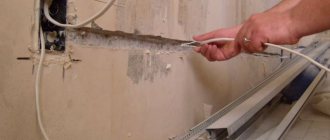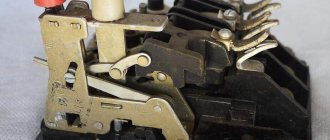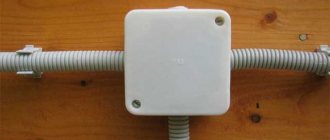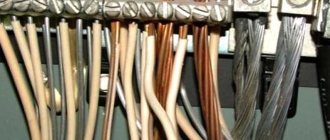Causes of electrical fires
A short circuit fire is caused by a number of factors. Let's look at some of them in more detail.
Violation of insulation and contact
Damage occurs as a result of oxidation of contact surfaces, caused by overheating. An increase in metal temperature causes it to expand and touch the cables. As a result, contact of two polarities occurs, causing a short circuit.
Errors in connection and cross-section of wires
The cause of a short circuit in the apartment may be cable contacts. The interaction of copper and aluminum wires causes diffusion. As a result, gradual heating to high temperatures occurs.
Wire size is also important. Any cable is designed for a certain load. Exceeding the permissible values at the joints causes heating, which can cause further ignition. Below is a table of correspondence between cable core thickness and maximum load.
Incorrect gasket
Cables located in the house, electrical room or on the roof of the room must be correctly connected and laid. Relevant for hidden wiring, where it is impossible to notice the moment of fire.
When installing a cable into a wall, you need to minimize sharp edges, as they can damage it during installation.
Questionable and faulty electrical appliances
The devices used must be of proper quality and have additional safety measures. For example, some kettle manufacturers increase the insulation of the wires, which reduces the risk of a short circuit.
Do not use devices with damaged plugs or cables.
Malfunction of protection devices
To minimize short circuits, a machine is installed at the entrance to the apartment. It will automatically turn off the power during a power surge, which will prevent a fire.
Damage to plugs and sockets
When electrical appliances are connected to the network, contacts interact, which become loose over time, leading to excessive heating. Such problems are characterized by crackling and sparking. The plug overheats, the socket melts, the contacts stick to each other, and a fire occurs.
Damaged socket
Faulty electrical wiring can cause a fire
Electrical wires have a certain service life. During operation, electrical wires are exposed to external environmental influences, which leads to premature wear, since, over time, the resistance in the electrical wiring is destroyed and increases - replacement of the electrical wiring . This leads to strong heating of the wires and can lead to spontaneous combustion of the wiring insulation and, possibly, to a fire in the room. A “short circuit” can also lead to a fire due to the destruction of insulation caused by the strong heating of the electrical wiring.
In a modern home there are electrical appliances that consume a large amount of electricity: a vacuum cleaner ~ 2500W, an electric kettle ~ 1800W, a microwave oven ~ 600-800W, etc., and if you add to this the lights on and constantly working: a refrigerator, TV and computer connected to the mains , then it is easy to calculate how much load falls on the electrical wires. In winter, heaters are added to this, and circuit breakers located in the electrical panel begin to operate, turning off the electricity in the apartment, thereby saving the electrical wiring from overload and fire.
SIP – Self-supporting insulated wire (SIP) . It replaced the usual non-insulated stranded aluminum wire, which can still be seen as part of high-voltage lines (OHL) in the private sector in many regions of our country. Bare wire was used in the past simply due to the lack of reliable insulating materials capable of serving in harsh outdoor conditions.
Due to the lack of insulation of the overhead line wires, during its installation it was necessary to use support insulators. Transmission lines took up a lot of space because it was necessary to maintain the distance between the wires. But, despite this, the wires often overlapped with each other, for example, in strong winds. Then there were short circuits and line breaks. In general, there were enough problems.
SIP immediately eliminated almost all these problems and issues. Cross-linked polyethylene insulation is not afraid of rain, wind, or sunlight and can serve faithfully for at least 25 years. For such conditions, the period is impressive. Installing an “air” using SIP does not take much time and effort, since a wide range of different fastening fittings have been developed for this wire. Everything has been thought out to the smallest detail: not installation, but pure pleasure.
For entry into the house, SIP 4 is used without a supporting cable with conductors of the same cross-section of 16 square meters. mm. SIP is an aluminum cable, and the use of aluminum with a cross-section of less than 16 square meters. mm., is currently prohibited by the electrical installation rules (PUE). A wire with a larger cross-section is simply not needed, since 16 squares is more than enough.
If the material from which the house is built is non-flammable, then the cable can be laid openly along the outer wall. True, this is not particularly aesthetically pleasing: thick black wicker SIP directly on the wall. It is especially unpleasant if the wall is a façade. Therefore, it is usually better to spend time and effort installing a plastic box or installing a corrugated pipe. And if the house is wooden, then this requirement becomes mandatory.
In order to preserve housing and property from fire, a complete replacement of electrical wiring in an apartment and in a private house is the most correct solution, and should only be carried out by a specialized organization.
Measures to prevent electrical fires
Preventing the sudden appearance of a lesion involves following these tips:
- When laying the wire, you should take into account the cross-sectional reserve.
- Insulate the cable with a gasket made of non-combustible materials.
- Avoid connecting the edges of wires inside the walls of an apartment, house, or entrance. It is impossible to detect their damage before the fire occurs.
- The cable used for wiring must be copper.
- The connection between copper and aluminum darts must be made by using a brass sleeve with special clamps. The use of improvised means is prohibited.
- If a malfunction of the device is detected, it is necessary to turn off the power to the apartment and call an electrician.
- When leaving home, turn off appliances from the network. When leaving for a long time, turn off the power to the machine.
As you can see, a wiring fire on the roof of a microdistrict or in an apartment can be prevented before it starts. All that is necessary is to follow these recommendations.
Alas, not everyone knows whether the wiring smells before a fire or what to do when a fire appears. Let's talk about eliminating it in more detail.
Short circuit - cause of fire
How to avoid it?
Since the beginning of the year, 16 fires have occurred in the Uzhur district. As a result, more than 600,000 rubles worth of material assets were destroyed. Unfortunately, there were casualties. The most common causes of fires are: violation of fire safety rules when operating stove heating and short circuits.
What is a short circuit? Causes of occurrence and how to avoid it.
A short circuit is a connection between a ground wire or a neutral wire and a phase wire, or between two phase wires. This results in the interaction of two conductors with different potentials. It is called a short contact because it occurred without an electrical appliance.
When such wires are connected, a small explosion occurs. This is explained by a sharp jump in current strength, reaching an unacceptable value. Such a rapid increase in current leads to overheating of the wires and the formation of an electric arc between them, the temperature of which reaches 5000 degrees C.
Particularly spectacular is the short circuit of phase wires in a three-phase electrical network. If a person shorts the phases with a screwdriver, he may be thrown several meters away and may receive serious injuries and burns. The screwdriver will simply evaporate. In everyday conditions, there may not be a big explosion, but melting of the wire and insulation is guaranteed, and this is a direct path to the ignition of objects that are nearby.
The causes of a short circuit are known:
old or damaged electrical wiring, incorrect installation (this is typical for amateurs with little understanding of electrical engineering), defective insulation, electrical appliances that do not meet electrical safety conditions (again, old or damaged), loose wire connections, accidental line breaks.
Any electrical appliance, wire or switch is designed for a certain current strength; if the current strength is higher than the norm for which the electrical wiring is designed, the wire heats up, electric arcs form with a temperature increase of up to 3000° and burning metal scatters.
This can be avoided by avoiding damage to wires, careless connections, corrosion or contamination of fuses; exposed or poorly insulated wires.
Electrical wiring should only be carried out by qualified technicians. Never do the wiring yourself. Do not replace the fuse with a larger fuse or with copper wiring; this violates control over the health of the electrical wiring.
Do not overload the power grid by turning on too many electrical appliances at the same time. Do not plug all your appliances into one outlet: overloading it may cause a fire.
Do not leave electrical appliances plugged in for a long time; they may overheat. Do not use faulty electrical appliances.
Following these simple rules will significantly reduce the risk of short circuits and fires. And it is important to remember that it is better to entrust work with electricity to a professional electrician. Then life will be calmer and safer!
Single rescue phone number “01” “101”, “112”.
Press service of the Uzhur fire and rescue garrison.
What to do if there is a wiring fire
Statistics show that people often do not know the rules of conduct when an electrical cable burns. The algorithm of actions in such a situation is as follows:
- De-energize the room. It is advisable to turn off the input machine.
- Put out the fire. If necessary, you can call a neighbor for help.
- When localizing the fire, do not touch surfaces. They're hot.
- The fire extinguishing agents used must not conduct current.
- If you realize that you cannot control the fire, call the fire department.
First actions
The causes of electrical panel fires in the entrances of microdistricts are often unknown. Despite this, the liquidation procedure has the following sequence:
- Do not panic. Do everything quickly, but calmly.
- Unscrew the plugs or turn off the machine.
- Evacuate women and children.
- Call the fire department.
- Eliminate the air supply. Close the windows and doors.
- Wet a towel and cover your nose with it.
- Find the source of the fire. Use available means to eliminate it (blanket, soil from flowerpots).
- If there is a great risk to your life, leave the premises. Wait for the rescuers. They will localize the fire and find out who is to blame.
- After extinguishing the fire, call an insurance representative and demand payment of compensation.
How to stew
Localizing a wiring fire can be done in four ways:
- Turn off the power to the burning network and use available means.
- Use fire extinguishers that correspond to the fire class. This option is more suitable for enterprises.
- Extinguishing non-de-energized wiring can only be done with sand or earth. The use of other improvised means is life-threatening.
- To put out fires in winter, you can use a snowball. A well-aimed hit at the source of fire will short-circuit the wiring and the machine will turn off.
In order to prevent network overload or short circuit, it is necessary to make simple calculations. If the wiring in the electrical panel smells, in order to avoid a fire, you need to take the device and inspect it. There is a video that describes in detail how to do this. If you are not confident in your own abilities, call an electrician.
Main reasons
An electrical fire can occur in the following situations:
- Short circuit. In this case, the temperature in the damaged area increases several times, melting the electrical wiring strands. Occurs due to breakdown of the insulating material (mechanical damage, microcracks, increased voltage, old electrical wiring).
- Network overload current. It is typical when connecting electrical equipment of increased power, the appearance of large leakage currents, and an increase in temperature in certain areas. These reasons also lead to overheating and subsequent fire.
- Often electrical wiring burns at the junction of current-carrying conductors. As a result of weakening or oxidation of the contact, the contact resistance of the electrical wiring sharply increases, which entails overheating and subsequent fire.
The most common cause of electrical fire is a faulty or damaged power cord for electrical appliances. If this happens, the first thing you need to do is disconnect the device from the mains, cover the fire area with a rag and put out the fire. Most apartments have flower pots, the soil from which is perfect for putting out flames.











